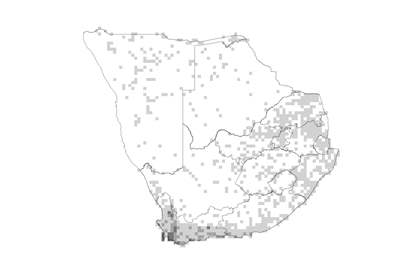 Species distribution and density. Darker squares represent higher density of members of this family. |
Introduction
Buffulo-thorn family
A large, cosmopolitan family of mostly trees and shrubs with inconspicuous white or green flowers. Their stipules are often modified into tendrils or hooked spines.
Distribution
Widely distributed throughout the world; in southern Africa the highest number of species is found in the Western Cape.
Number of genera in the world
ca. 52
Number of species in the world
ca. 925
Number of genera in the Flora of southern Africa region
10
Number of species in the Flora of southern Africa region
201
Well-known southern African genera
Berchemia, Phylica, Rhamnus, Ziziphus
Growth forms
Mostly trees and shrubs (erect or rarely climbing).
Habitats
Found in a wide range of habitats including tropical rain forest, savanna, fynbos and arid areas like karoo and desert.
Flagship species
Rhamnus prinoides (dog wood; blinkblaar [A]; umnyenye [Z]) is a scrambling shrub or small tree found along forest margins and stream banks. The leaves are dark green and shiny with neatly serrated margins. The small, greenish flowers are borne from November to January and attract insects. The red, fleshy fruit are eaten by birds. The roots and leaves are used for medicinal and magical purposes and it is often planted as a decorative garden and hedge plant.
Significance of the family
Some species are used as ornamental plants (*Ceanothus, Helinus, Phylica, Ziziphus) or the source of dyes (Rhamnus). Also used for medicinal purposes, e.g. to treat wounds, chest problems, backache and cholera and as a laxative (Helinus, Rhamnus, Ziziphus). The roots contain saponin, which froths when mixed with water, and is used as a soap substitute. Fresh or candied dried fruit of jujube (*Ziziphus zizyphus) are eaten as a snack, especially in the Middle and Far East. Introduced species of Rhamnus and Ziziphus may become invasive.
Diagnostic characters
Leaves simple, usually alternate or spirally arranged, sometimes opposite or subopposite (Berchemia, Lasiodiscus, Scutia); some with 3-5 main veins from the base (Ziziphus) and a glossy surface . Stipules small or modified into tendrils or spines � (absent in Phylica). Flowers small, regular and inconspicuous with 4 or 5 free, often reduced petals and 4 or 5 stamens . Nectar-secreting disc usually present �. Ovary mostly superior � (inferior in Helinus). Fruit usually a fleshy drupe . (Photo : GN).
Did you know?
The San used juice from Ziziphus mucronata as a mixing agent for arrow poison, which they obtained from beetle larvae.